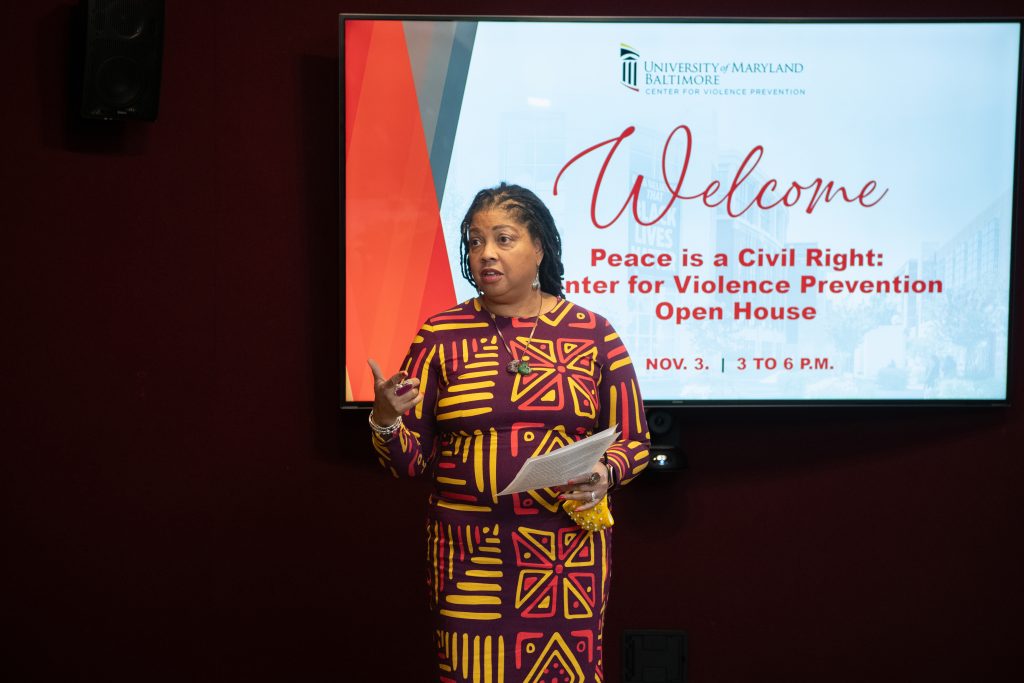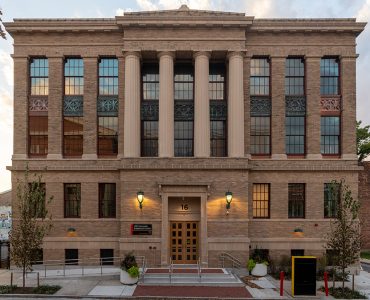
As a college student in the 1990s, Nadine Finigan-Carr, PhD, MS, executive director of the University of Maryland, Baltimore’s (UMB) Center for Violence Prevention, thought she wanted to be a doctor.
“Like a lot of people in my generation, I knew I was going to grow up to be a doctor. I was going to med school,” Finigan-Carr said.
Two summers working as a patient advocate at New York’s Bellevue Hospital changed all that. It’s been 30 years, and Finigan-Carr is still moved close to tears recalling a shift in the emergency room where she was assigned to a young man who had been shot in the head.
“They’d done all they could to stabilize him,” she recalled. “They’d removed him from life support, and my job for the next three days was to monitor his vital signs.”
She wasn’t working when the man died, but the experience prompted a profound shift in her thinking, she says. “It really changed me. I realized I didn’t want to be there after something happened. I needed to stop the bullets from coming.”
To that end, Finigan-Carr, a prevention research scientist and internationally recognized expert on human trafficking and sexual exploitation of minors, is the inaugural executive director of the newly established UMB Center for Violence Prevention (CVP).
Funded by a $2 million gift from Betsy Sherman and the Sherman Family Foundation, CVP brings together the expertise and resources of two of Baltimore’s major anchor institutions — UMB and the R Adams Cowley Shock Trauma Center at the University of Maryland Medical Center. Finigan-Carr sees the new center as an “organizing umbrella” that will connect the numerous research and clinical programs already in place at UMB that address violence and the social determinants of health related to trauma.
The center takes a comprehensive, collaborative, and unique approach by partnering with schools, programs, and community organizations already doing related work in Baltimore. And rather than just responding after violence occurs, it aims to prevent violence on multiple levels — from primary prevention like conflict resolution skills to secondary and tertiary interventions in hospitals.
“We want to work ‘upstream’ to stop violence before it starts,” Finigan-Carr said. “That means focusing on primary prevention versus just responding after trauma occurs. We want to get mediation programs into communities so that conflicts don’t become altercations and altercations don’t become Shock Trauma visits.”
Since stepping into the role May 1, Finigan-Carr has been busy meeting with community stakeholders and UMB administrators as she works to determine how to best serve Baltimore and the University.
“I’ve met with just about all of the deans,” she said. “I’m excited to work with them, and we’re already seeing key places where we will be working together.”
While meeting with UMB administrators is essential to the success of CVP, Finigan-Carr is adamant that the center be community-driven. She meets regularly with local community partners including the Mayor’s Office of Neighborhood Safety and Engagement, Leaders of a Beautiful Struggle, and the Baltimore Community Mediation Center.
“We don’t want to just go into communities and say, ‘We can fix this,’ ” Finigan-Carr said. “We want to work with community organizations already in this space to develop the programs, develop the research, and connect it to what’s already happening here at UMB.”
Working with Youths
Gun violence has continued to impact Baltimore and its residents. As of Nov. 26, there have been 233 homicides in the city this year, according to the Baltimore Police Department.
Finigan-Carr says a key goal is creating a program to develop Baltimore youth as “peace ambassadors” to mediate conflicts and disrupt violence in their schools and neighborhoods. She envisions the program will be similar to YouthWorks, the Baltimore City program that provides summer job opportunities for young people.
“Is it only young people committing crimes in our city? No,” Finigan-Carr said. “But if we’re talking about working upstream, if we address issues among them, we will reduce issues of violence in the long run.”
The center hosted an open house Nov. 3 as part of Baltimore’s third Peace Promise Weekend of 2023. The open house was an opportunity for Baltimore community members and activists as well as the UMB community to explore the center’s new offices in the Health Sciences and Human Services Library and learn more about the center’s work.
The timing was no coincidence. Finigan-Carr has monthly strategy sessions with organizers of Baltimore Peace Movement, formerly known as Baltimore Ceasefire 365, who are behind the Peace Weekend efforts. The Baltimore Peace Movement is a community-based group that works to end violence in Baltimore and holds four Peace Weekends each year to promote nonviolence and support those affected by violence.
Interdisciplinary Collaboration
Finigan-Carr expressed excitement about the potential impact of interdisciplinary collaboration on violence prevention. The CVP website launched a Universitywide survey in time for the open house that was designed to lay out the violence prevention programs at the different schools.
“In all seven of our schools, we have people who are doing violence prevention, trauma prevention, and trauma-informed research,” Finigan-Carr said. “Everyone is doing these programs and everyone has the same complaint” of having no connection.
“We want to become a repository of information,” she said. “We want to connect the different programs and coordinate our community-based work so our education, community-based advocacy, and research will be even more effective.”
While the work of the Center for Violence Prevention is just beginning, Finigan-Carr has hope for her adopted city of Baltimore. Ten years from now, she said, “I want to be able to say that in Baltimore, my Baltimore, we’re walking hand in hand in communities that are trauma-free, equitable, and enjoyable.”
Read more about Nadine Finigan-Carr in this issue of CATALYST.



